
* Following development of the landmark DC-3 / C-47 twin-piston airliner, the Douglas firm went on to develop a four-engine successor, which emerged as the "DC-4", mostly produced as the military "C-54". While not as successful as the DC-3, the DC-4 was built in good numbers, and led to improved "DC-6" and "DC-7" derivatives, which were also built in fair numbers. This document provides a history and description of the DC-4, DC-6, and DC-7.

* In 1935, in response to a requirement from United Air Lines, the Douglas firm began work on a four-engine airliner to follow the company's twin-engine DC-3. The new airliner, of course the "DC-4", was to have twice the passenger capacity of the DC-3, with 42 passenger seats, or 30 seats as a sleeper transport, along with cabin pressurization and climate control.
The prototype performed its first flight on 9 June 1938. It was a low-wing aircraft, made mostly of aircraft aluminum alloy, with a triple-fin tail; power-boosted controls; four radial engines; and tricycle landing gear, at the time an innovation. Length was 29.74 meters (97 feet 7 inches), wingspan was 42.14 meters (138 feet 3 inches), and empty weight was 19,305 kilograms (42,565 pounds). Powerplants were Pratt & Whitney (P&W) Twin Hornet 14-cylinder two-row air-cooled radials, providing 1,080 kW (1,450 kW) each. The engines were toed out slightly to improve engine-out handling; three tailfins were used to ensure that the aircraft could keep flying more or less straight if both engines on one wing went down.

Service evaluation by United showed that the DC-4 was underpowered and as overly complicated, making it expensive to maintain. In response to requests from United and Eastern Air Lines, Douglas decided to simplify and downsize the design, again giving it the designation of "DC-4", with the original DC-4 being retroactively designated the "DC-4E", with "E" for "experimental". The DC-4E was sold off to Imperial Japanese Airways, which at the time was being used as a "front" operation by the Japanese government to obtain advanced aeronautical technologies from other countries for evaluation. The DC-4E was reverse-engineered, to be used as the basis for the Nakajima G5N heavy bomber, which did not enter production.
* While design work on the "new" DC-4 proceeded, World War II broke out, and US aircraft manufacturers switched to military production. The US Army Air Forces (USAAF) liked the DC-4 design and decided to bring it into the service inventory as the "C-54 Skymaster", the US Navy to also obtain it as the "R5D". The first C-54 performed its initial flight on 14 February 1942.
The C-54 retained the same general configuration as the DC-4E, but it was generally a new design. The C-54 was somewhat scaled down -- with shorter span and length, empty weight being reduced to 90% of the DC-4E -- and had a single tailfin instead of the triple-fin tail. Pressurization was also eliminated.
The wings had three spars, a dihedral, and were of tapered planform; each wing had a one-piece single-slotted flap inboard and an aileron outboard, with a trim tab on the right aileron. Tail flight controls were conventional, elevators and rudder, with the tailfin featuring a forward fin fillet and the rudder featuring a trim tab. Although the wing had all-metal flight control surfaces, the tail surfaces had metal frames with fabric covering. Most photos of C-54s show them to have leading-edge pneumatic de-icing boots, but some photos don't show the boots; it is unclear which production had them and which did not.
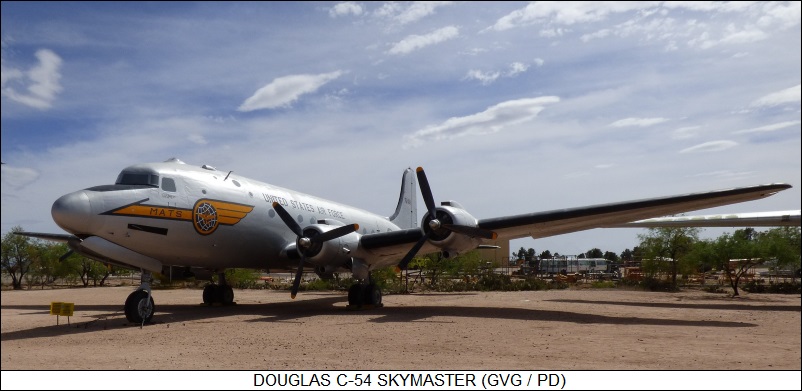
The C-54 was powered by P&W R-2000-3 Twin Wasp engines providing 1,010 kW (1,350 HP) take-off power, 820 kW (1,100 HP) at low altitude, and 750 kW (1,000 HP) at high altitude, driving three-bladed Hamilton Standard variable-pitch propellers. There were integral wing fuel tanks and four fuel tanks in the fuselage, providing a total fuel capacity of 13,568 liters (3,580 US gallons). The fuselage tanks were additions specified by the military, which needed extended range; all tanks were also self-sealing, another clearly military feature.
The steerable nose landing gear had a single wheel and retracted forward; each main gear had twin wheels, and retracted forward into the inboard engine nacelle. There was a bumper under the rear fuselage to protect against tail strikes. Avionics were typical for the era, including flight instrumentation; radio; radio compass; and, in time, presumably identification friend or foe (IFF) transponder, as well as improved navigation aids, refitted as they were introduced in the course of the war. There was an astrodome behind the cockpit for taking navigation sightings.
There were typically six crew, including pilot, co-pilot, radio operator, navigator, and two relief crew. There was a rest compartment with toilet and bunks behind the cockpit, along with a lavatory, wardrobe, and buffet in the rear for passenger use. There was a passenger door in the rear on the left, a crew door up front on the right, and emergency exit windows placed near the front and back of the wing on both side; oval windows ran up the sides. The initial C-54 was strictly a personnel transport, with 26 seats; it is unclear why so few seats were fitted, one possibility being a trade-off with fuel. There were inflatable life rafts for crew and passengers, as well as personal emergency oxygen supplies.
BACK_TO_TOP* Only 24 baseline C-54s were built, all at the Douglas plant in Santa Monica, California. They were followed by the fully militarized "C-54A", introduced in early 1943, which featured:
While early C-54A production retained the R-2000-3 engines, later production had R-2000-7 engines, with technical improvements but the same power rating. 252 C-54As were built in Santa Monica and at a new plant at Orange Place, Chicago. The primary user was the US Army Air Forces' Air Transport Command (USAAF ATC).
___________________________________________________________________
DOUGLAS C-54A SKYMASTER:
___________________________________________________________________
wingspan:
35.81 meters (117 feet 6 inches)
wing area:
135.9 sq_meters (1,463 sq_feet)
length:
28.63 meters (93 feet 11 inches)
height:
8.39 meters (27 feet 6 inches)
empty weight:
17,235 kilograms (38,000 pounds)
max take-off weight:
33,110 kilograms (73,000 pounds)
cruise speed:
385 KPH (240 MPH / 210 KT)
service ceiling:
6,700 meters (22,000 feet)
range with full load (26 passengers or 4,355 kilograms / 9,600 pounds):
4,025 kilometers (2,500 MI / 2,175 NMI)
range with typical load:
4,800 kilometers (3,000 MI / 2,605 NMI)
___________________________________________________________________
* The "C-54B" was introduced in the spring of 1944. It eliminated two of the fuselage tanks to increase cabin space, adding tanks in the outer wings to compensate, total fuel capacity being 14,175 liters (3,740 US gallons). The metal bucket seats were replaced by frame-cloth seats, which were lighter and more comfortable, with passenger capacity raised to 49, and the number of litters raised to 36. It retained the R-2000-7 engines. 220 C-54Bs were built at Santa Monica and Chicago.
There was only one "C-54C" -- or more precisely "VC-54C", this being the first purpose-built US presidential aircraft, in effect the first "Air Force One". When President Franklin D. Roosevelt flew to the Casablanca Conference in 1943 on board a commercial Boeing 314 Clipper Ship flying boat, he became the first US president to fly while in office. Concerned about relying upon commercial airlines to transport the president, USAAF leaders ordered conversion of a military transport to support the presidential mission.
Initial work focused on the C-87A, a transport version of the Consolidated Liberator bomber, but it didn't work out, with the C-54 then being chosen for the job. The VC-54C airframe was a customized item, featuring a C-54A airliner fuselage and the C-54B wings, with the outer wing tanks -- total fuel capacity being about 20% more than the C-54B, a total of 17,093 liters (4,510 US gallons). The SACRED COW, as it was known, had a crew of seven and could carry the president along with 14 staff. It had a stateroom, three conference rooms, and an electric lift to make it easier for the president, who was confined to a wheelchair, to get in or out.
Roosevelt flew on the SACRED COW to Yalta in early 1945; this was apparently his only flight on the aircraft, since he died soon after. The SACRED COW was, however, retained in service by the Truman Administration for over two more years. On 26 July 1947, President Truman signed the National Security Act of 1947 while on board the VC-45C -- removing the USAAF from Army control and so establishing the modern US Air Force (USAF) as an independent service.
* The "C-54D" was effectively the same as the C-54B, but with improved R-2000-11 engines, with better high-altitude performance. 380 C-54Ds were built, all at Chicago; those configured as staff / VIP transports were designated "VC-54D".
The "C-54E" was similar to the C-54D but had no fuselage tanks, providing additional bag tanks in the inner wings to give a (reduced) fuel capacity of 13,416 liters (3,540 US gallons); it also had a "quick change" interior. 125 were built, all at Santa Monica.
The "C-54G" was similar to the C-54E, but reverted to R-2000-9 engines. 162 were built, all at Santa Monica; those configured as staff transports / VIP machines were designated "VC-54G". A single "XC-114", with Allison V-1710 vee-12 engines plus a fuselage stretch, and a similar "XC-116", with thermal de-icing instead of pneumatic boots, were also built. 79 commercial "DC-4-1009" airliners were built in the postwar period. That gave a total US production of 1,245 DC-4s, variants including:
Of that production, 183 were passed on from the USAAF to the US Navy as R5Ds, with subvariants as follows:
There was a confusing set of subvariant designations for the R5D family, with an "R" suffix standing for a personnel transport ("R5D-4R"), while the "F" and later "Z" suffixes stood for staff / VIP transports ("R5D-1F" / "R5D-1Z").
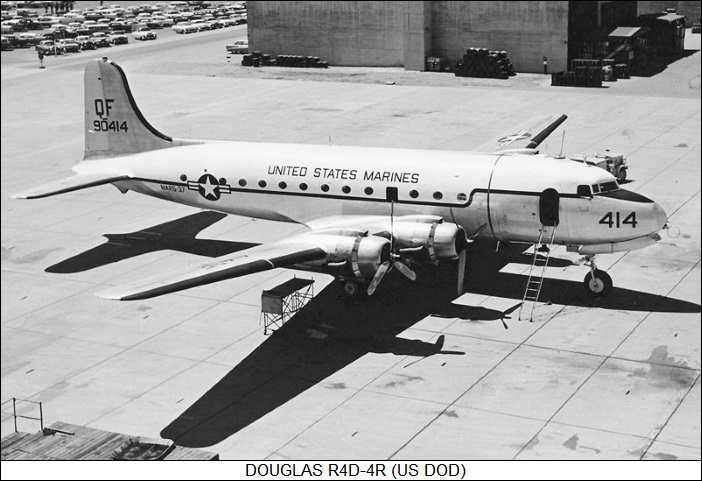
In 1962, when the US military went to a unified designation scheme, the R5Ds were redesignated as follows:
There were modifications of these designations based on subvariant; for example, a staff / VIP transport would have a "V" suffix ("VC-54S"). Trying to nail down all the variations would be an exercise in frustration. One C-54B was provided to the UK for use as Prime Minister Winston Churchill's personal transport, with 22 C-54Ds later provided to the British Royal Air Force. All 23 were designated "Skymaster Mark I". Survivors were returned to the US after the war.
Hand-me-down C-54s were flown by the military forces of Argentina, Belgium, Brazil, Colombia, Cuba, Denmark, Ethiopia, France, Honduras, Mexico, Peru, Portugal, Rhodesia, Saudi Arabia, South Africa, Spain, Thailand, and Turkey. The C-54 was the backbone of the Berlin Airlift, the "air lifeline" to Berlin in consequence of the Soviet blockade of the city in 1947 and 1948. A number of C-54s were actually used to haul coal to Berlin, these machines being stripped down to increase payload, and redesignated "C-54M".
The C-54 also performed extensive duties in the Korean War, being used for personnel and cargo haulage, plus medical evacuation; C-54Es configured for 30 litters and accommodations for medical attendants for that role were designated "MC-54M".
BACK_TO_TOP* The C-54 / R5D remained in US military service into the 1960s; hundreds were passed on to civil users after the conflict, being used in airliner or freighter configuration. There were also a number of special-purpose modifications:
* Along with US production, the DC-4 was built in Canada as the "North Star". In 1944, the new Canadair firm took over the assets of Canadian Vickers LTD, with one of the first items on Canadair's agenda being the development of an airliner for postwar use. The Douglas C-54 seemed like a promising basis for such an aircraft, so a Douglas-built airframe was obtained and fitted with Rolls-Royce Merlin 620 water-cooled vee-12 engines with 1,285 kW (1,725 HP) each, this machine being given the company designation of "Canadair CL-2". It took to the skies on 20 July 1946.
That experiment working well -- the one flaw being the Merlin engines were noisier than the Twin Wasps -- 23 unpressurized production machines were built, with the prototype brought up to operational standard. All 24 CL-2s were obtained by the Royal Canadian Air Force (RCAF), being given the military designation of "North Star Mark 1". They saw extensive use during the Korean War, and were later modified into a dedicated passenger transport configuration under the designation of "North Star Mark 1 ST". They were finally withdrawn in the mid-1960s.
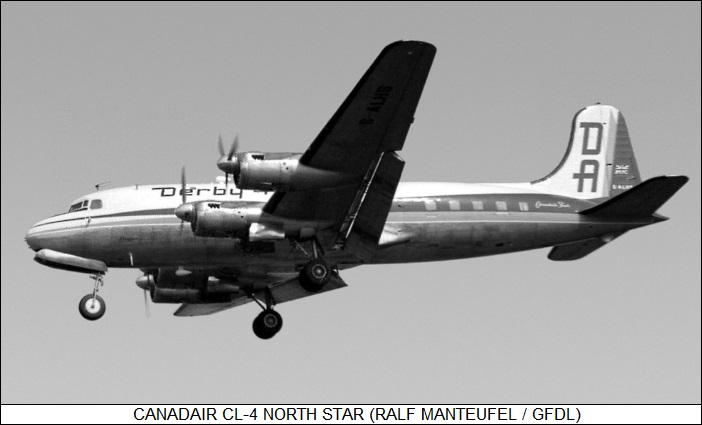
Trans-Canada Airlines ordered 20 "Canadair CL-4" machines that had, with arrangement for multiple classes with 40 seats, or 62 seats in a pure economy configuration. While waiting for delivery, the airlines obtained six North Star Mark 1s on lease, designating them "DC-4M-1" or "North Star M1"; following deliveries of the CL-4 machines from 1947, the RCAF machines reverted to their previous operator. The CL-4 machines were designated "DC-4M-2" AKA "North Star M2", some being later converted to air freighters. There was a confusing series of subvariant designations depending on configuration and engine fit, not belabored here.
British Overseas Airways Corporation (BOAC) also obtained 22 CL-4 machines as the "C-4 Argonaut", being flown from 1949 to 1960, and four were obtained by Canadian Pacific Air Lines as "North Star C-4", again with a confusing series of subvariant designations. One last "CL-5", reverting to P&W R-2800 Twin Wasp engines, was built for the RCAF, ending Canadian production at 24 + 20 + 22 + 4 + 1 == 71 machines.
* With plenty of ex-military C-54s on the market in the postwar period, it wasn't surprising that some of them were put to exotic uses. The most impressive were the "Carvair (Car Via Air)" conversions of 21 C-54s, performed by Aviation Traders of the UK, run by British airline entrepreneur Sir Freddy Laker. The idea was that they could haul both passengers and their cars.
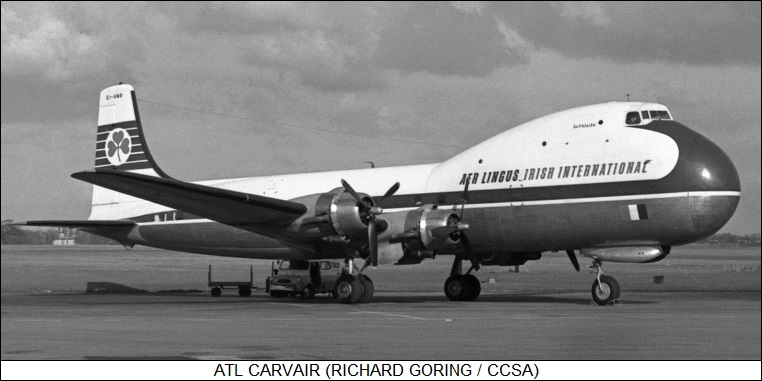
The Carvairs were fitted with a new forward fuselage, featuring the cockpit raised above the fuselage to accommodate a nose that hinged to one side to allow automobiles to be driven in. The Carvair was also fitted with a larger tailfin to deal with yaw instability caused by the raised forward fuselage, as well as stronger wheel brakes, with the nose wheel gear doors being bulged since the nose wheel didn't fit completely in like it did before the modification. The Carvair could handle five cars, with 22 passengers in the rear compartment; or three cars and 55 passengers; or 65 passengers. Initial flight of a Carvair was on 21 June 1961, with the last of the 21 turned out in 1968. The Carvair was a cute idea, but exactly how much commercial sense it made is unclear. They actually had a fairly active service career, though eight were lost in accidents. Some survive as static displays.
BACK_TO_TOP* In 1944, the USAAF requested that Douglas come up with a pressurized, stretched derivative of the DC-4, with more powerful engines. The result, the "XC-112A", performed its first flight on 15 February 1946 -- but by that time World War II was over, with the US military shrinking rapidly and little money for new aircraft. Douglas, however, continued development of the aircraft as the "DC-6", with the first example performing its initial flight on 29 June 1946, with initial deliveries, to American and United Airlines, before the end of the year. The prototype was fitted up to production standard and sold. A series of inflight fires, including one that led to a fatal crash, led to the grounding of the DC-6 fleet in 1947, but they were back in the air in 1948.
The initial DC-6 (no suffix) variant was difficult to tell from a DC-4, the biggest giveaway being that the windows were rectangular instead of oval. The DC-6 was stretched by 2.06 meters (6 feet 9 inches) to 30.66 meters (100 feet 7 inches), giving normal passenger load of 48 to 52 seats -- but 86 passengers could be carried in a high-density all-economy arrangement. MTOW was raised to 44,100 kilograms (97,200 pounds). It retained the Double Wasp engines, though they were the more powerful R-2800-CA15 variant, with 1,565 kW (2,100 HP) and water injection.
There was also a long-range variant of the DC-6 with a few less seats, more fuel capacity, appropriately higher MTOW, and more powerful -CB16 engines with 1,790 kW (2,400 HP). A total of 174 DC-6 machines was built, including one "VC-118" -- Harry Truman's "Air Force One" VIP transport, named INDEPENDENCE, after his hometown of Independence, Missouri. It had seats for 24 passengers -- convertible to 12 sleeper berths -- and a stateroom in the rear. It was delivered in 1947, served in the presidential role to 1953, to be used by the USAF up to 1965. It is now on display at the Air Force Museum at Wright-Patterson Air Force Base in Ohio.
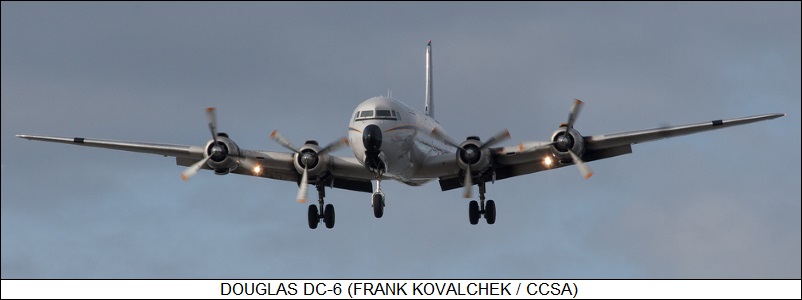
* The DC-6 was followed by the "DC-6A", which was a pure cargo variant, with C-54-style double doors aft of the wing and a lift-up cargo door ahead of the wing, both on the left side. It also had a fuselage stretch of 1.52 meters (5 feet), the fuselage length being 32.18 meters (105 feet 7 inches); MTOW was further raised to 48,600 kilograms (107,200 pounds). Some had passenger windows, some didn't; they retained the -CB16 Twin Wasp engines.
___________________________________________________________________
DOUGLAS DC-6A:
___________________________________________________________________
wingspan:
35.81 meters (117 feet 6 inches)
wing area:
135.9 sq_meters (1,463 sq_feet)
length:
32.18 meters (105 feet 7 inches)
height:
8.66 meters (28 feet 5 inches)
empty weight:
20,805 kilograms (45,860 pounds)
MTOW:
48,600 kilograms (107,200 pounds)
cruise speed:
510 KPH (315 MPH / 275 KT)
service ceiling:
6,700 meters (22,000 feet)
range with full load:
5,460 kilometers (2,565 MI / 2,950 NMI)
___________________________________________________________________
73 civilian DC-6A machines were built, along with 101 "C-118A Liftmaster" machines for the US Air Force. The C-118As had some military kit and a convertible interior to allow them to carry cargo, 74 passengers, or 20 litters. Liftmasters configured as VIP transports were designated as "VC-118A", with medical machines being designated "MC-118A". A few C-118As were also fitted up with cameras for aerial survey, being redesignated "RC-118A". The US Navy acquired 65 "R6D-1" machines, much like the C-118A, four of them being VIP machines designated "R6D-1Z"; they were redesignated "C-118B" and "VC-118B" respectively in 1962.
The DC-6A was followed in 1951 by the "DC-6B", which was much the same airframe but fitted out strictly as an airliner. Typical passenger capacity was 54, with high-density all-economy seating for 102. 288 were built up to end of DC-6 production in 1958, giving total DC-6 production as 1 + 174 + 73 + 101 + 65 + 288 == 702. One DC-6B was used as a VIP transport by Yugoslav President Josip Broz Tito, with this machine eventually being acquired by the drink maker Red Bull for its flight demonstration fleet.
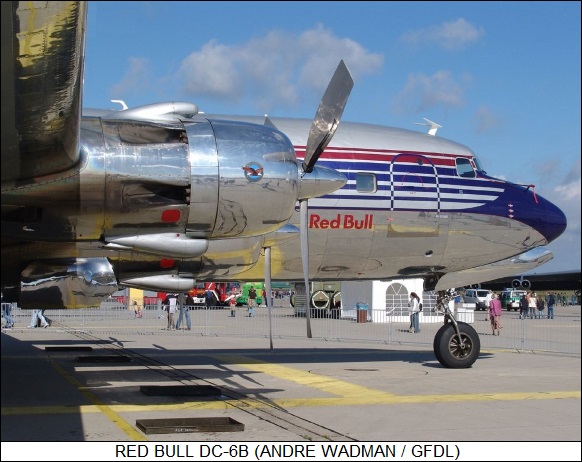
There was also a "DC-6C", which was a convertible passenger-cargo version of the DC-6A; it appears their production count was included in DC-6A production. SABENA of Belgium also performed freighter conversions of two DC-6Bs as "swing-tail" cargolifters, with a tail that swung to one side for loading of bulk cargo.
BACK_TO_TOP* Following the introduction of the DC-6B, American Airlines requested that the Douglas company come up with a pressurized airliner that could fly across the USA nonstop, backing up the request with an order for 25 aircraft. American wanted to get a step ahead of Trans-World Airways -- which was doing well with the Lockheed Super Constellation airliner -- by obtaining a comparable but more capable aircraft.
The result was the "DC-7", which was much like the DC-6B, except that it was stretched 1.02 meters (40 inches) to add another row of seats, extending total length to 33.2 meters (108 feet 11 inches). Landing gear was reinforced to handle higher MTOW. The DC-7 was powered by Wright R-3350-18EA-1 Turbo-Compound 18-cylinder two-row air-cooled radials, derived from the Wright Twin Cyclone engine, but with triple exhaust-driven "power recovery turbines", and providing a monster 2,425 kW (3,250 HP) each. Unlike the C-54 and DC-6, which had three-bladed props, the DC-7 had four-bladed props, providing a distinctive recognition feature. It featured 99 passenger seats in an all-economy layout. Initial flight of the DC-7 prototype was on 18 May 1953, with initial service flights by the end of the year. 105 DC-7s were sold in all.

The DC-7 was followed by the "DC-7B", with slightly uprated Turbo-Compound engines, a further reinforced airframe to handle higher MTOW, and (as an option) "saddle" tanks in the rear of the engine nacelles to increase range for trans-Atlantic service. 112 DC-7Bs were sold in all.
Even the saddle tanks weren't enough to provide comfortably international range, so Douglas then developed the "DC-7C", which had 1.5-meter (5-foot) wing inserts at the root to provide more wing area and fuel capacity. The extended wings had the added benefit of spacing the engines away from the fuselage and reducing cabin noise. The fuselage was also extended another 1.04 meters (40 inches) to a total length of 34.21 meters (112 feet 3 inches), giving space for 105 passengers in an all-economy configuration. To handle the higher MTOW, the DC-7C used further uprated Turbo-Compound engines with 2,535 kW (3,400 HP). The size of the tailfin and tailplane were increased as well. The DC-7C was marketed, as a play on its designation and its trans-oceanic range, as the "Seven Seas". 121 DC-7C airliners were built in all, giving a total of 105 + 112 + 121 == 338 DC-7 series airliners.
___________________________________________________________________
DOUGLAS DC-7C:
___________________________________________________________________
wingspan:
38.8 meters (127 feet 6 inches)
wing area:
152 sq_meters (1,637 sq_feet)
length:
34.23 meters (112 feet 3 inches)
height:
9.65 meters (31 feet 8 inches)
empty weight:
33,005 kilograms (72,765 pounds)
MTOW:
64,865 kilograms (143,000 pounds)
cruise speed:
555 KPH (345 MPH / 300 KT)
service ceiling:
6,700 meters (22,000 feet)
range with full load:
5,810 kilometers (3,605 MI / 3,135 NMI)
___________________________________________________________________

The DC-7 saw little or no military service. From 1959, Douglas ran a program to convert DC-7, DC-7B, and DC-7C machines into "DC-7F" freighters. The aircraft were fitted with large forward and rear freight doors, while some cabin windows were deleted. There was consideration of a "DC-7D" with Tyne turboprops, but the airlines were moving on to pure jet airliners, and the DC-7D was seen as a nonstarter. The DC-7 lingered in cargo hauler service late into the century.
BACK_TO_TOP* The jump from the DC-4 to DC-6 designation leaves hanging the question: "So what happened to the DC-5?" There actually was a DC-5, but it didn't amount to much. Following the success of the DC-3, the Douglas company decided to develop a smaller twin-piston airliner with 16 to 22 passenger seats. Working from the Douglas DB-7 -- the initial prototype of what would become the A-20 Havoc medium bomber -- the firm came up with the DC-4, which performed its initial flight on 20 February 1939.
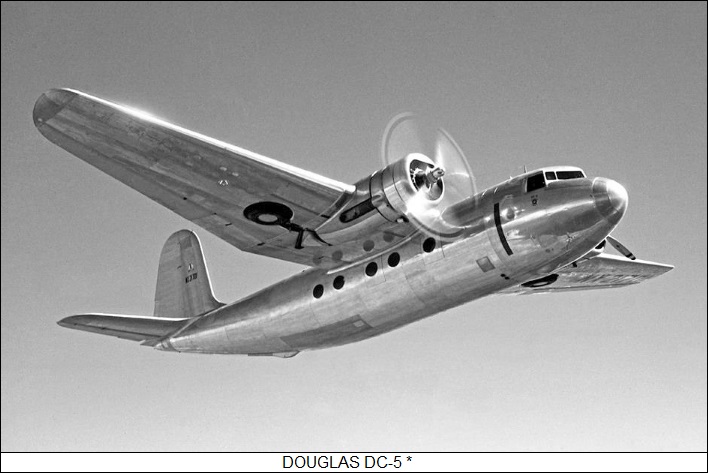
The DC-5 was innovative, being an all-metal aircraft featuring tricycle landing gear -- the main gear retracting outward from the engine nacelles into the wings, and high wings -- meaning the fuselage was relatively low to the ground, simplifying loading. This configuration would end up being common among modern turboprop airliners. The DC-5 had a length of 18.96 meters (62 feet 2 inches), a wingspan of 23.77 meters (78 feet), and an empty weight of 6,245 kilograms (13,675 pounds). It was powered by two Wright GR-1820-F62 9-cylinder Cyclone radials, providing 670 kw (900 HP) each.
Only a dozen were built, including the prototype, four commercial airliners, and seven transports for the Navy / Marines as the "R3D". The four airliners were obtained by the Dutch KLM airline, and served in the Far East; one was captured by the Japanese, to be flown in Japanese markings, while three were used by the USAAF in Australia -- one ultimately making its way to Israel.
* One item I didn't mention above was the fact that late in their lives, a fair number of DC-4 / C-54s, DC-6s, and DC-7s ended up in the "air tanker" role, being fitted with a belly pack to carry water or retardant to fight wildfires. I used to occasionally see them flying over my house during fire seasons. They survived in this role into the 21st century, but have now been grounded, having exceeded airframe life, and too antiquated to support.
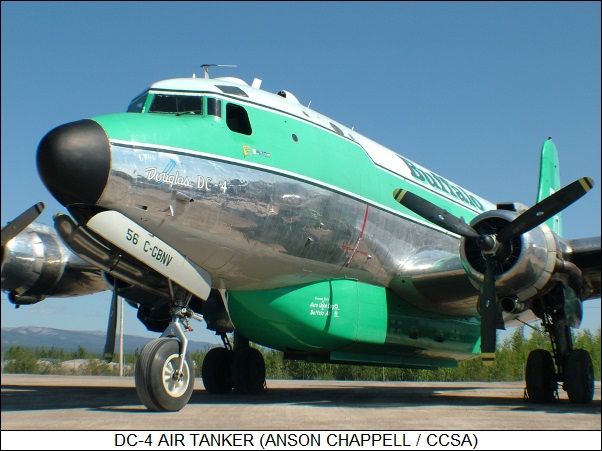
Not to worry, however: the airlines being pressured by the rising expense of fuel, they've been inclined to get rid of older jetliners that aren't so fuel-efficient, even though such machines may have plenty of airframe life left in them, and there's a plentiful supply of jetliner airframes for a new generation of air tankers. The next time a nasty fire season comes along, I should at least see some interesting air tankers flying around.
* I was intrigued by the notion of a turboprop-powered DC-7 with Tyne engines, and on considering the idea, I got to imagining a "DC-7T" with Tynes, and a further fuselage stretch. Given the higher take-off weight, it might be appropriate to add a fifth Tyne in the nose -- the result being a "what-if" "Super DC-7T".
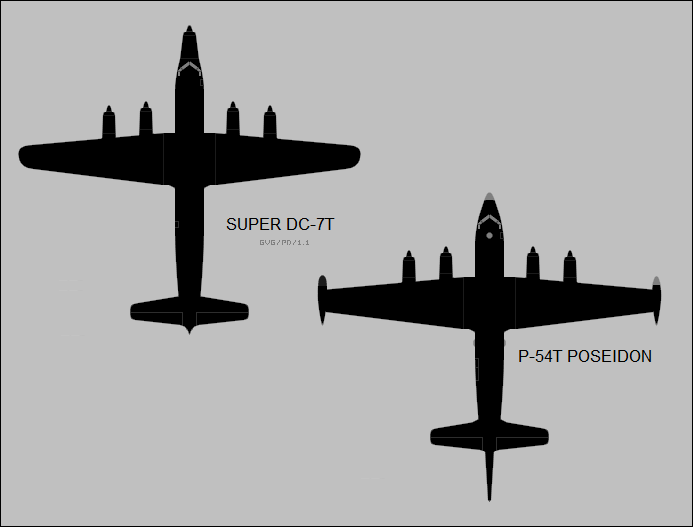
OK, maybe that's a little implausible, but what about a C-54 airframe with DC-7 wings and tail, kitted out for the ocean patrol mission? It would feature a glazed nose for observation, bulged observation windows behind the wing, large cargo door for paradropping rescue kit, bomb bay and sonobuoy launcher, a magnetic anomaly detector boom on the tail, radar in a pod on the left wingtip, and searchlight on the right wingtip. It wouldn't be quite a P-3 Orion, but it would be about as believable as "what if" aircraft could be. What to call it? "P-54T Poseidon" sounds good.
A reader, on seeing this idea, suggested a "DC-7CD Sky Sentry" airborne early warning platform based on the DC-7, with Allison T56 engines, a radar disk above the rear fuselage, and a big tailfin fillet to ensure yaw stability. A model has been made of the Sky Sentry; hopefully, the Poseidon will be represented in model form in time.
* There is a certain inevitable confusion in this document, due to the fact that so few DC-4s were produced as such, the great majority of the design being produced as military C-54s. To make it more confusing, the C-54 was a clearly different machine from the original DC-4 and DC-4E prototypes. Nonetheless, it proved much simpler and more consistent in writing this document to establish the C-54 as the military version of the DC-4 -- and not sweat the fact that this was getting things somewhat backwards.
* Sources include:
I also got comments off the relevant Wikipedia articles.
* Revision history:
v1.0.0 / 01 aug 14 v1.0.1 / 01 jul 16 / Review & polish. v1.1.0 / 01 jun 18 / Considerable cleanup. v1.1.1 / 01 apr 20 / Review & polish. v1.1.2 / 01 feb 22 / Review & polish. v1.2.0 / 01 jan 23 / Reformatting and rechecking.BACK_TO_TOP
